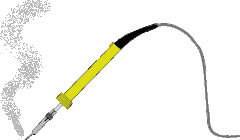A De-Soldering Primer
By
Wayne Burdick, N6KR
Removing resistors and other parts from
double-sided boards is easy and
fun. After years of careful analysis of my own
technique I have documented
the process. I start with technique #1, below;
if that doesn't work, I try
#2, etc. Good luck!
1. Turn the board over. With one hand
behind your back, a wry smile, and
the confidence of a pet surgeon, simply heat
the lead in question and
listen for the pleasant sound of the component
hitting the work bench.
2. Well, that *would* be too easy,
wouldn't it. Staying with the solder
side for now, locate a large solder sucker
(the larger the better; it
should frighten smaller pets when brandished).
Heat each joint and deftly
suck out the solder with a single satisfying
Thwop! Listen for the part
hitting the bench.
3. Didn't fall out, eh? No problem:
rummage in that tool bin for a shiny
new roll of solder wick. Crack open a beer,
too, and take a generous swig.
Wedge that wick in between the lead and pad,
heat until you see the solder
flow nicely onto the wick, and pull it out of
the way just in time to see a
beatiful, black annular ring around your
component lead. Nudge each lead
with your iron and keep your fingers crossed.
4. OK, so you've got a tough customer:
small lead, hole just barely
larger, and a bit of off-color solder that
can't be bothered with any of
the usual techniques. Have another sip of that
brew. Vigorously flip the
board back to the component side. Now grip the
lead professionally with
your most elegant long-nose pliers and hold on
tight. Give it a playful
yank, then pray. Should pop right out.
5. Damn. Finish the beer and get out
your brutal, 8" electrician's
long-nose. Grab the component with gusto this
time, buster, then tip the
board up at a 45. Turn up your soldering
station to max and heat that baby
up on the backside. Pull down hard with the
pliers.
6. No go? Hmmmm -- let's get serious.
Put the board up directly on its
edge and hold it in place vertically with your
chin. Since your iron is
suspect by this time, test it for several
seconds on the nearest exposed
skin. (Doing it by accident is just as
effective.) Heat the joint with
*feeling* this time. Lunge and parry. Don't
worry about the pad, traces,
or other parts--this is war! With maximal chin
pressure exerted to hold
the offending board in place, pull the lead
out, out, Out!
7. OK, so you "...couldn't get
hold of it...," blah blah blah. Fool!
You must risk everthing at this stage. Insert
a small screwdriver under
the part, and white-knuckle that soldering
iron on the obverse. Pry and
heat until it pops. (Note: It is important to
keep in mind the concept of
"kick-back" should you succeed at
this. PC boards are likely to
wobble, flop, slip, then fling out of your
grasp once the offending little
monster finally lets go, taking test leads and
soldering station with it.)
8. So, what kind of inept dweeb are
you, anyway? Give up! Clip the part.
Leave some lead to grab onto and repeat #6 and
7. If your face has turned
red it is best to shield the work from veiw
with your body, then steal a
quick look behind you to be sure noone is
suppressing a giggle as they
watch this humiliating display.
9A. The lead came out but you STILL
have some solder left in the hole?
Gads. Find another part that you can
sacrifice. Press its helpless
lead into the depressingly small pit you made
in the center of the pad.
Heat the base of the lead until you achieve
Punch-Through. Yank and Heat,
Yank and Heat. Evetually the solder will give
up in disgust and the
sacrificial component lead will slide
smoothly, signalling victory.
9B. To your left is a hand drill; to
your right is a #60 bit. You know
what you must do.
10. Now—you brute!— now that you've
overheated the pad, broken the trace,
cracked the component, gouged the board,
pitted the tip, blistered the
skin, wasted a beer, and irrefutably proven
once and for all that you
should have taken up gardening instead, NOW
maybe you'll learn the color
code!
;)
N6KR
Thanks Wayne! Been there! Done ALL that! This brought to mind the time I soldered in a 16 pin logic chip on a double sided board... UPSIDE DOWN. TRIBAL KNOWLEDGE MY FRIENDS.
Our book: "SolderSmoke -- Global Adventures in Wireless Electronics"
http://soldersmoke.com/book.htm
Our coffee mugs, T-Shirts, bumper stickers:
http://www.cafepress.com/SolderSmoke
Our Book Store:
http://astore.amazon.com/contracross-20




